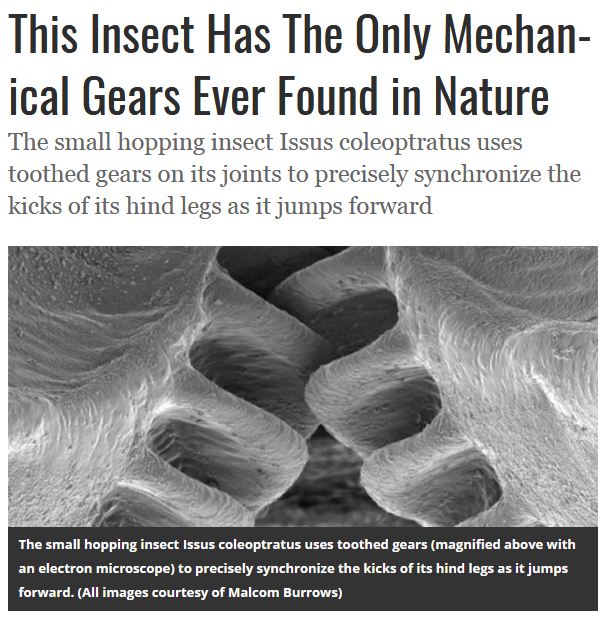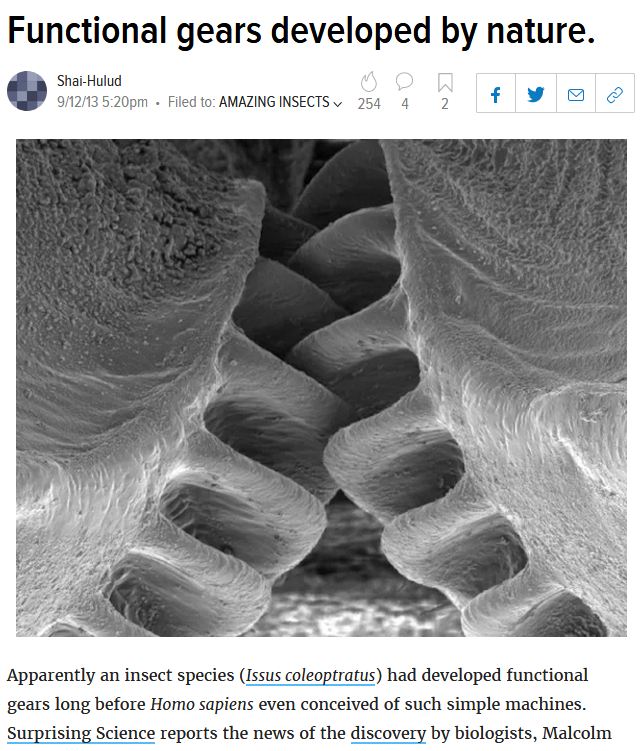 To the best of our knowledge, the mechanical gear - evenly-sized teeth cut into two different rotating surfaces to lock them together as they turn was invented sometime around 300 B.C.E. by Greek mechanics who lived in Alexandria. In the centuries since, the simple concept has become a keystone of modern technology, enabling all sorts of machinery and vehicles, including cars and bicycles.
To the best of our knowledge, the mechanical gear - evenly-sized teeth cut into two different rotating surfaces to lock them together as they turn was invented sometime around 300 B.C.E. by Greek mechanics who lived in Alexandria. In the centuries since, the simple concept has become a keystone of modern technology, enabling all sorts of machinery and vehicles, including cars and bicycles.
As it turns out, though, a three-millimeter long hopping insect known as Issus coleoptratus beat us to this invention.
On the contrary, this insect has been digitally programmed (read this series) to develop such a mechanism in its younger stage, as is apparent from empirical evidence at the dna-gene-cell level. There is a digital code to biological life, which has syntax, rules and grammar. This is what allows variation in the first place and includes a pre-engineered, built in adaptive capacity in response to stimuli. This explains the diversity and variation in life, and all of it returns to a common source, which is a knowing, willing, able creator. The undeniable evidence for this is the sum of human enterprise in industry and technology -- which is the empirical evidence that purposeful design involving high levels of abstraction, coding, translation, encryption, decryption, error checking and so on, requires knowledge, will, wisdom and power. This is indisputable. There is no escape from this except to invent an alternative explanation to compete with this one (as the natural, instinctive explanation cannot be falsified by any means whatsoever, including the scientific method).
To counter this, materialists, naturalists and atheists first claim all of this is merely illusion of design, a "trick" nature has played on their minds. After treating what their physical senses tell them as one big illusion (a sign of madness), they then concoct their own competing version of a creation story involving random physico-chemical dynamics, warm alphabet soups and blind-watchmakers, and they throw these aforementioned attributes onto nature. In other words, the very things that have been acted upon by the exercising of these attributes are given these very attributes to deny and reject the existence of the possessor of these attributes. Stripped of all encryption, this story is basically saying that an artefact (such as a pen for example) is the possessor of the attributes of the one who designed and manufactured it, and thus there is no knowledge, will, wisdom and ability involved, it is merely an illusory trick that the pen plays on our minds. These people have just found a very clever way of disguising this basic form of fallacious reason, when they apply it to nature.
 Malcolm Burrows and Gregory Sutton, a pair of biologists from the University of Cambridge in the U.K., discovered that juveniles of the species have an intricate gearing system that locks their back legs together, allowing both appendages to rotate at the exact same instant, causing the tiny creatures jump forward.
Malcolm Burrows and Gregory Sutton, a pair of biologists from the University of Cambridge in the U.K., discovered that juveniles of the species have an intricate gearing system that locks their back legs together, allowing both appendages to rotate at the exact same instant, causing the tiny creatures jump forward.
The finding, which was published today in Science, is believed to be the first functional gearing system ever discovered in nature. Insects from the Issus genus, which are commonly called "planthoppers," are found throughout Europe and North Africa. Burrows and Sutton used electron microscopes and high-speed video capture to discover the existence of the gearing and figure out its exact function.
The reason for the gearing, they say, is coordination: To jump, both of the insect's hind legs must push forward at the exact same time. Because they both swing laterally, if one were extended a fraction of a second earlier than the other, it'd push the insect off course to the right or left, instead of jumping straight forward.
The gearing is an elegant solution. The researchers' high-speed videos showed that the creatures, who jump at speeds as high as 8.7 miles per hour, cocked their back legs in a jumping position, then pushed forward, with each moving within 30 microseconds (that's 30 millionths of a second) of the other.
The finely toothed gear in their legs allow this to happen. "In Issus, the skeleton is used to solve a complex problem that the brain and nervous system can't," Burrows said in a press statement.
The gears are located at the top of the insects' hind legs (on segments known as trochantera) and include 10 to 12 tapered teeth, each about 80 micrometers wide (or 80 millionths of a meter). In all the Issus hoppers studied, the same number of teeth were present on each hind leg, and the gears locked together neatly. The teeth even have filleted curves at the base, a design incorporated into human-made mechanical gears because it reduces wear over time.
To confirm that the gears performed this function, the researchers performed a neat (albeit morbid) trick with some dead Issus. They manually cocked their legs back in a jumping position, then electrically stimulated the main jumping muscle in one leg so that the leg extended. Because it was rotationally locked by the gears, the other non-stimulated leg moved as well, and the dead insect jumped forward.
The main mystery is the fact that adults of the same insect species don't have any gearing as the juveniles grow up and their skin molts away, they fail to regrow these gear teeth, and the adult legs are synchronized by an alternate mechanism (a series of protrusions extend from both hind legs, and push the other leg into action).
Burrows and Sutton hypothesize that this could be explained by the fragility of the gearing: if one tooth breaks, it limits the effectiveness of the design. This isn't such a big problem for the juveniles, who repeatedly molt and grow new gears before adulthood, but for the mature Issus, replacing the teeth would be impossible hence the alternate arrangement.
There have been gear-like structures previously found on other animals (like the spiny turtle or the wheel bug), but they're purely ornamental. This seems to be the first natural design that mechanically functions like our geared systems.
And wait for it... here it comes:
 "We usually think of gears as something that we see in human designed machinery, but we've found that that is only because we didn't look hard enough, Sutton said. "These gears are not designed; they are evolved representing high speed and precision machinery evolved for synchronisation in the animal world."
"We usually think of gears as something that we see in human designed machinery, but we've found that that is only because we didn't look hard enough, Sutton said. "These gears are not designed; they are evolved representing high speed and precision machinery evolved for synchronisation in the animal world."
We'll leave you to pick up your entrails after the uncontrollable fits of laughter caused your sides to split, and let you stitch them together again. And while you do that, this is what will be said to such arrogant people for their denial:
 يَٰمَعْشَرَ ٱلْجِنِّ وَٱلْإِنسِ أَلَمْ يَأْتِكُمْ رُسُلٌ مِّنكُمْ يَقُصُّونَ عَلَيْكُمْ ءَايَٰتِى وَيُنذِرُونَكُمْ لِقَآءَ يَوْمِكُمْ هَٰذَا قَالُوا۟ شَهِدْنَا عَلَىٰٓ أَنفُسِنَا وَغَرَّتْهُمُ ٱلْحَيَوٰةُ ٱلدُّنْيَا وَشَهِدُوا۟ عَلَىٰٓ أَنفُسِهِمْ أَنَّهُمْ كَانُوا۟ كَٰفِرِينَ
يَٰمَعْشَرَ ٱلْجِنِّ وَٱلْإِنسِ أَلَمْ يَأْتِكُمْ رُسُلٌ مِّنكُمْ يَقُصُّونَ عَلَيْكُمْ ءَايَٰتِى وَيُنذِرُونَكُمْ لِقَآءَ يَوْمِكُمْ هَٰذَا قَالُوا۟ شَهِدْنَا عَلَىٰٓ أَنفُسِنَا وَغَرَّتْهُمُ ٱلْحَيَوٰةُ ٱلدُّنْيَا وَشَهِدُوا۟ عَلَىٰٓ أَنفُسِهِمْ أَنَّهُمْ كَانُوا۟ كَٰفِرِينَ 
 O you assembly of jinn and mankind! "Did not there come to you Messengers from amongst you, reciting unto you My Verses and warning you of the meeting of this Day of yours?" They will say: "We bear witness against ourselves." It was the life of this world that deceived them. And they will bear witness against themselves that they were (indeed) disbelievers. (6:130)
O you assembly of jinn and mankind! "Did not there come to you Messengers from amongst you, reciting unto you My Verses and warning you of the meeting of this Day of yours?" They will say: "We bear witness against ourselves." It was the life of this world that deceived them. And they will bear witness against themselves that they were (indeed) disbelievers. (6:130) 


You must be registered and logged in to comment.
 Articles
Articles

 To the best of our
To the best of our  يَٰمَعْشَرَ ٱلْجِنِّ وَٱلْإِنسِ أَلَمْ يَأْتِكُمْ رُسُلٌ مِّنكُمْ يَقُصُّونَ عَلَيْكُمْ ءَايَٰتِى وَيُنذِرُونَكُمْ لِقَآءَ يَوْمِكُمْ هَٰذَا قَالُوا۟ شَهِدْنَا عَلَىٰٓ أَنفُسِنَا وَغَرَّتْهُمُ ٱلْحَيَوٰةُ ٱلدُّنْيَا وَشَهِدُوا۟ عَلَىٰٓ أَنفُسِهِمْ أَنَّهُمْ كَانُوا۟ كَٰفِرِينَ
يَٰمَعْشَرَ ٱلْجِنِّ وَٱلْإِنسِ أَلَمْ يَأْتِكُمْ رُسُلٌ مِّنكُمْ يَقُصُّونَ عَلَيْكُمْ ءَايَٰتِى وَيُنذِرُونَكُمْ لِقَآءَ يَوْمِكُمْ هَٰذَا قَالُوا۟ شَهِدْنَا عَلَىٰٓ أَنفُسِنَا وَغَرَّتْهُمُ ٱلْحَيَوٰةُ ٱلدُّنْيَا وَشَهِدُوا۟ عَلَىٰٓ أَنفُسِهِمْ أَنَّهُمْ كَانُوا۟ كَٰفِرِينَ 









